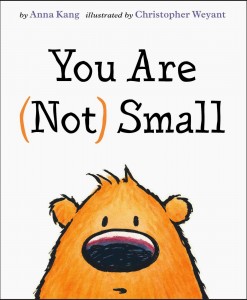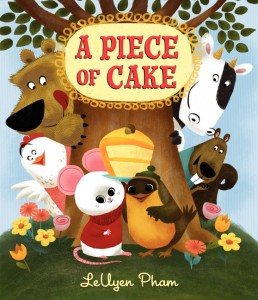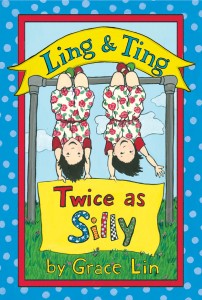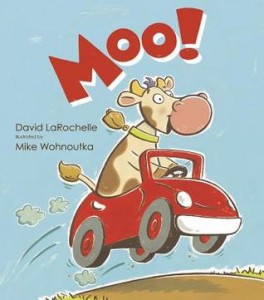The winner is: You Are (Not) Small!
 Happy Book Award Season! Many of us look forward to the annual announcement of the Caldecott and Newbery Medal Awards from the American Library Association, but the one that made me hoot and holler loudest this year was the announcement of the winner of the Theodor Seuss Geisel Award for the most distinguished beginning reader book: You Are (Not) Small written by Anna Kang and illustrated by Christopher Weyent.
Happy Book Award Season! Many of us look forward to the annual announcement of the Caldecott and Newbery Medal Awards from the American Library Association, but the one that made me hoot and holler loudest this year was the announcement of the winner of the Theodor Seuss Geisel Award for the most distinguished beginning reader book: You Are (Not) Small written by Anna Kang and illustrated by Christopher Weyent.
Fantastic “easy” reader? Check.
Great for Readers’ Theater? Check.
Funny ending? Check.
Works for a ton of tie-in lessons? Check.
Story and art that kids will want to return to again and again? Big ol’ check!
Finding mentor texts on expressing opinion, giving reasons, persuasion, etc. isn’t easy for the younger crowd, so if you teach kindergarten – third grade, grab You Are (Not) Small. (It’s also fantastic for a print concepts lesson on italics, ellipses, underlining, for a lesson on reading with expression, for a math/science tie-in for comparing items by size, but I digress.)
The two main characters in this book express clear, opposite opinions. The orange fuzzy creature tells the purple fuzzy creature, “You are small.” The purple fuzzy disagrees, “I am not small. You are big.” Back and forth they go, giving reasons for their opinion by comparing themselves to other fuzzy creatures. It’s so simple it’s brilliant, and the ending will get everyone giggling.
After reading this to a first grade class, I told them, “You are small.” Uproar ensued. “No, we aren’t!”
“Yes, my opinion is that you are small, and my reason is that you are all smaller than this bookshelf.”
“But we’re bigger than the chair!” “Yes, and we’re taller than the desk!”
This led to an easy quick-write session: choose an opinion statement of “I am big” or “I am small” and write three reasons to support your opinion. Go!
So grab You Are (Not) Small by Anna Kang and Christopher Weyant, and check out other winners of the Theodor Seuss Geisel Award. The Caldecott and Newbery Medals are wonderful, but they aren’t the only awards given by ALA, so explore lists like the Coretta Scott King Awards and treat yourself to award-winning books.
Read More
A Piece of Cake
 Every December I see lists of the best books of the year, and every year there’s at least one gem that I can’t believe isn’t getting more love. My choice this year for the “Don’t Miss This Picture Book” award is A Piece of Cake by LeUyen Pham (whose first name is pronounced “LeWin” but she mostly goes by “Win”. Now you know.)
Every December I see lists of the best books of the year, and every year there’s at least one gem that I can’t believe isn’t getting more love. My choice this year for the “Don’t Miss This Picture Book” award is A Piece of Cake by LeUyen Pham (whose first name is pronounced “LeWin” but she mostly goes by “Win”. Now you know.)
Pham had me from the moment she made the cover art reminiscent of a Golden Book, even down to her swirly signature. It starts like a sweet, simple story. A kind Mouse bakes a birthday cake for Little Bird, but then – there are all these unexpected surprises!
Mouse is bringing the cake to Little Bird’s house when Chicken stops him. Chicken wants a piece of cake, and the very kind Mouse has trouble saying no. Chicken, who is surrounded by eggs and is reading a book while sunning herself says, “If you give me a piece of that cake, I’ll trade you…” An egg, right? Nope! A cork, from Chicken’s bottle of suntan lotion.
At each stop on Mouse’s walk to and from Little Bird’s house, Pham sets us up to call out an obvious answer and then she delivers a twist that gets readers giggling. It reminds me of Guess Again by Mac Barnett and Adam Rex, but A Piece of Cake has a strong plot and internal logic as well as silly surprises. The cork that Chicken gave is used later for another unexpected purpose. It’s the ideal picture book to work on prediction and comprehension (Key Ideas and Details, anyone?)
Read this book aloud for the sheer pleasure of it, and then for the second reading, make a chart where kids can write what they thought would happen and what actually happened. “I thought Chicken would give Mouse ____ but then Chicken gave Mouse _________.” This is also a great story to act out for the whole group and then in centers so students can see what happens with each object. Make a Storybox with the characters and objects from the story for students to retell, and building comprehension skills will be A Piece of Cake.
Read More
Ling & Ting & Grace & Me!
 If you heard a loud, squeeing sound on November 11, that was me. I’m thrilled because the newest book in an early chapter book series I adore was just released: Ling & Ting: Twice as Silly by Grace Lin. I’m twice as excited about this book, because I wrote the Ling & Ting story starters that you can download and use with your students for FREE and it’s on Grace Lin’s website! My work on gracelin.com! I’m swooning to be linked with such a rock star!
If you heard a loud, squeeing sound on November 11, that was me. I’m thrilled because the newest book in an early chapter book series I adore was just released: Ling & Ting: Twice as Silly by Grace Lin. I’m twice as excited about this book, because I wrote the Ling & Ting story starters that you can download and use with your students for FREE and it’s on Grace Lin’s website! My work on gracelin.com! I’m swooning to be linked with such a rock star!
Grace Lin also has an exceptionally cool contest going on. Kiddos who are inspired to make up a silly story the way Ling and Ting do can receive a free Ling & Ting print and be entered to win a Pocket Pacy! The details are all available on Grace Lin’s blog.
Early chapter books like the Ling & Ting books are wonderful for building fluency. Each chapter is only a few pages long, so it’s easy to turn a chapter into a Readers’ Theater script. Also, you can work on comprehension skills (go, Key Ideas & Details and even Integrating Knowledge & Ideas if you compare two or more of the books) by making a Ling & Ting Venn diagram. Ling and Ting are twins, but we find out in their first book Ling & Ting: Not Exactly the Same that identical twins don’t have identical personalities. If you have twins in your classroom, they will be especially delighted to help point out the way the girls are different as well as the ways they are the same!
This month I’m presenting seminars in Oklahoma City, Dallas, Houston, Anaheim, and Pasadena. All in one week. I’ll be very thankful this Thanksgiving to be done traveling for 2014. As I count my blessings, I’ll also give thanks for you, for letting me share my passion for kids’ books with you.
P.S. Thanks Curious City for connecting me with Grace Lin. I’m still grinning!
Read MoreMoo!
 It’s the beginning of a new school year and we want all our students to start off feeling successful. If you have kids that are beginning or struggling readers, here is a book that almost everyone will be able to read confidently: Moo! written by David LaRochelle and illustrated by Mike Wohnoutka.
It’s the beginning of a new school year and we want all our students to start off feeling successful. If you have kids that are beginning or struggling readers, here is a book that almost everyone will be able to read confidently: Moo! written by David LaRochelle and illustrated by Mike Wohnoutka.
This is no boring “baby book”. The humor of this one works for a wide range of kids, especially if you model reading it aloud with great expression. I read this one for an all-ages Stories in the Park event this summer and even the grown-ups were chuckling. Even though the book consists almost entirely of one word, the punctuation, the text formatting, and the pictures determine how the word is read. So not only is it a bull’s-eye for the Core Standard of Fluency, it works beautifully into a lesson on punctuation and Print Concepts.
Read Moo! aloud to your students and, once the giggles die down, talk about how you knew how to read the same word differently. For example, look at this page from the book:  There are moos in italics, in bold font, in all capitals and these differences, along with the punctuation, help determine how to read this page. Share the book again, asking different students to use the text and picture clues to help them read the page with feeling. Now you’ve got a lead-in to a great writing exercise. Brainstorm two lists: a list of punctuation and text styles that were used to change the meaning of “moo” so many times, and a list of animals that make a sound. Kids can write and draw about an animal that goes off on an adventure (using punctuation and formatting to show meaning) and they’ll only have to worry about spelling one word. Fun!
There are moos in italics, in bold font, in all capitals and these differences, along with the punctuation, help determine how to read this page. Share the book again, asking different students to use the text and picture clues to help them read the page with feeling. Now you’ve got a lead-in to a great writing exercise. Brainstorm two lists: a list of punctuation and text styles that were used to change the meaning of “moo” so many times, and a list of animals that make a sound. Kids can write and draw about an animal that goes off on an adventure (using punctuation and formatting to show meaning) and they’ll only have to worry about spelling one word. Fun!







